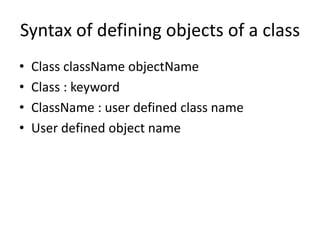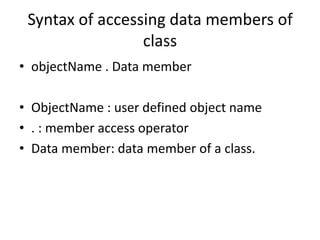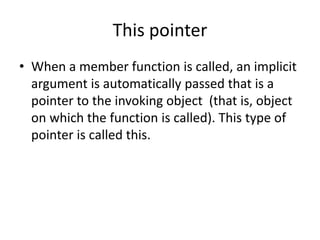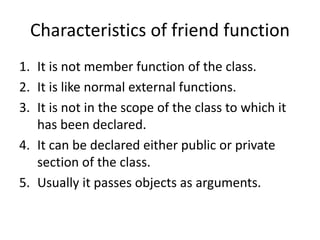Classes and objects
- 1. CLASSES AND OBJECTS ANIL KUMAR https://www.facebook.com/AniLK0221
- 2. INTRODUCTION • C++ class mechanism allows users to define their own data types that can be used as conveniently as build in types. • Classes are often called user defined types. • Includes defining of class types and creation of objects of classes.
- 3. Cont………… • The class definition introduces both : • the class data members that define the internal representation of class • The class member functions that define the set of operations that may be applied to objects of class type.
- 4. Cont…………. • Information hiding is achieved by declaring the data members as private whereas the operations to be performed on class objects by the program are public.
- 5. What is class? • Created using keyword class. • A class declaration defines a new user defined data type that links code and data. • The new data type is then used to declare objects of that class. • Class is a logical abstraction but an object has physical existence. • Objects is an instance of class.
- 6. Cont………. • The class is the cornerstone of C++ – It makes possible encapsulation, data hiding and inheritance – A user defined type – Consists of both data and methods – Defines properties and behavior of that type
- 7. Syntax of Class declaration • Class className • { • // body of a class • }
- 8. Cont……………. • The class definition has two parts: • Class head : composed of keyword class followed by the class name • Class body: enclosed by a pair of curly braces.
- 9. General form of class declaration • Class className • { • Access_specifier_1: • Members; • Access_specifier_2: • Members; • …… • } • objectName;
- 10. Cont………… • The objectName is optional. • If present, it declares objects of the class.
- 11. Example of student class • Class student • { • Int rollNo; (data members) • Char name [25]; • Char addr [35]; • Public: • Void getdata(); (member functions) • Void display(); • } • ;
- 12. Cont……… • The class data members and member functions are declared within the body of the class along with their access levels. • The class body defined the class member list and their scope. • If two classes have members with the same name, the program will not show any error since the members refer to different objects.
- 13. Access specifier • Public • Private • Protected
- 14. Public • Public members may be accessed by member functions of same class and functions outside the scope of the class (anywhere inside the program)
- 15. Private • Private members may only be accessed by member functions and friend function of the class. • A class that enforces information hiding declares its data members as private.
- 16. Protected • The protected members may be accessed only by the member functions of its class or by member functions of its derived class.
- 17. Cont……….. • The data hiding is achieved by declaring data members in the private section of the class. • Since the private members are not accessible from outside the class, they will be accessed by the publicly declared member functions of the same class.
- 18. Defining a class class box { Public: Int a,b,c; Data Members void get() { cin>>a>>b>>c; } void put() Member Functions { cout<<a<<b<<c; } };
- 19. C++ IT 3rd Sem Object-Oriented Programming: Class: class <class-name> { access-specifier: variable declarations function declarations access-specifier: variable declarations function declarations access-specifier: variable declarations function declarations };
- 20. Example • Class rectangle • { • Int length; • Int width; • Public: • Void setvalues (int, int); • Int area(); • };
- 21. Cont……….. • It declares a class rectangle. The class contains four members: • Two data members length and width of type integer in the private section (because private section is default permission) • Two member functions: • Setvalues (int, int) and area() in the public section.
- 22. C++ IT 3rd Sem Object-Oriented Programming: Object: class <class-name> { access-specifier: variable declarations function declarations access-specifier: variable declarations function declarations } ob1; //object creation void main() { <class-name> ob2; //object creation
- 23. Objects A class provides the blueprints for objects, so basically an object is created from a class. Object can be called as an instance of a class. We declare objects of a class with exactly the same sort of declaration that we declare variables of basic types. Following statements declare two objects of class Box: Box Box1; Box Box2;
- 24. Cont……….. • The definition of class does not cause any storage to be allocated. Storage is only allocated when object of class type is defined. • The process of creating objects of the class is called class instantiation.
- 25. Syntax of defining objects of a class • Class className objectName • Class : keyword • ClassName : user defined class name • User defined object name
- 26. Object Operations All operations that can be applied to basic data types can be applied to the objects. E.g.: • Arithematic • Relational • Logical
- 27. Example • Class rectangle • { • Int length; • Int width; • Public: • // member functions • }; • The definition • Rectangle rect;
- 28. Cont……….. Will allocate the memory space sufficient to contain the two data members of the rectangle class. The name rect refers to that memory location. Each class object has its own copy of the class data members. • An object of a class type also has a lifetime.
- 29. Data members • Declared in the same way as the variables are declared. • Generally, all data members of a class are made private to that class. • If data members are declared in the public section of the class, they will be accessed using member access operator, dot (.).
- 30. Syntax of accessing data members of class • objectName . Data member • ObjectName : user defined object name • . : member access operator • Data member: data member of a class.
- 31. Member functions • Functions that are declared within a class are called member functions. • Works on data members of class. • Member functions can access any element of the class of which they belong to. • The member functions of a class are declared inside the class body.
- 32. Syntax of accessing member functions of a class • objectName . functionName (Actual Arguments) • objectName: user defined object name • . : member access operator • functionName: name of the member function • Actual arguments: arguments list to the function
- 33. Cont………… • Member functions are declared within the scope of their class. It means member function is not visible outside the scope of its class.
- 34. Member function can be defined in two ways • Inside the class • Outside the class
- 35. Functions defined inside the class • Member function of a class can be defined inside the class declaration. • Its syntax is similar to a normal function definition except that it is enclosed within the body of a class.
- 36. Example • The member function in the rectangle class can be defined as follows: • Class rectangle • { • Int length; • Int width; • Public: • Void setvalues(int x, int y) • { • Length = x; • Width = y; • } • Int area () • { • return(length * width); • } • } ;
- 37. Cont……. • In this the class contains two member functions in the public section: Setvalues(int, int) Area() • They are defined inside the class itself.
- 38. Functions defined outside the class • In this method, the prototype of the member function is declared within the body of the class and then defined outside the body of the class. • Functions defined outside the class have the same syntax as the normal function, there should be a mechanism of binding to the class to which they belong.
- 39. Cont…………… • This requires a special declaration. • The name of the member function must be qualified by the name of its class by using the scope resolution operator. ( : : )
- 40. General format of member function definition • Class className • { • …… • returnType memberFunction (arguments); • User defined class name • } • ;
- 41. Member function definition outside the class • returnType className :: memberFunction (arguments) • { • // body of the function • }
- 42. Object-Oriented Programming Using C++, Third Edition 42 Implementing Class Functions • When you construct a class, you create two parts: – Declaration section: contains the class name, variables (attributes), and function prototypes – Implementation section: contains the functions • Use both the class name and the scope resolution operator (::) when you implement a class function
- 43. Object-Oriented Programming Using C++, Third Edition 43 Implementing Class Functions (continued)
- 44. Object-Oriented Programming Using C++, Third Edition 44 Using Static Class Members • When a class field is static, only one memory location is allocated – All members of the class share a single storage location for a static data member of that same class • When you create a non-static variable within a function, a new variable is created every time you call that function • When you create a static variable, the variable maintains its memory address and previous value for the life of the program
- 45. Static variable • Static variables are sometimes called class variables, class fields, or class-wide fields because they don’t belong to a specific object; they belong to the class. • Initialized and allocated storage only once at the beginning of the program execution. • No matters how many times they are called and used in the program. • Retains its value until the end of the program.
- 46. Chapter 11 Starting Out with C++: Early Objects 5/e slide 46 © 2006 Pearson Education. All Rights Reserved Static Members • Static variables: - Shared by all objects of the class - Like a “global variable” among objects of the class • Static member functions: - Can be used to access static member variables - Can be called before any objects are created
- 47. Chapter 11 Starting Out with C++: Early Objects 5/e slide 47 © 2006 Pearson Education. All Rights Reserved Constant Member Functions • Declared with keyword const • When const follows the parameter list, int getX() const; (in the class definition) int X::getX() const (defined outside the class) the function is prevented from modifying the object – can’t change the object attributes • When const appears in the parameter list, int setNum (const int num) the function is prevented from modifying the parameter. The parameter is read-only.
- 48. Chapter 11 Starting Out with C++: Early Objects 5/e slide 48 © 2006 Pearson Education. All Rights Reserved The this Pointer and Constant Member Functions • this pointer: - Implicit parameter passed to a member function (by the compiler) - points to the object calling the function • const member function: - does not modify its calling object
- 49. This pointer • When a member function is called, an implicit argument is automatically passed that is a pointer to the invoking object (that is, object on which the function is called). This type of pointer is called this.
- 50. Chapter 11 Starting Out with C++: Early Objects 5/e slide 50 © 2006 Pearson Education. All Rights Reserved Using the this Pointer • Can be used to access members that may be hidden by parameters with same name: class SomeClass { private: int num; public: void setNum(int num) { this->num = num; } };
- 51. Constant keyword • In c++, constant keyword is used to make program elements constant. Constant keyword can be used with: • Variable • Pointer • Function arguments and return types • Class data member • Class member function • objects
- 52. C++ IT 3rd Sem Object-Oriented Programming: Types of Member Functions: Inline Functions Nested Functions Friend Functions Static Functions Virtual Functions
- 53. FRIEND FUNCTION • The protected and private members cannot be accessed from outside the same class at which they are declared. • Its possible to grant a non member function access to the private members of a class, by using a keyword friend.
- 54. Cont……… • A friend function has access to all private and protected members of the class for which it is friend.
- 55. Syntax of friend function • Class rectangle • { • …… • ….. • Public: • …… • …… • Friend rectangle duplicate (rectangle) • }
- 56. Characteristics of friend function 1. It is not member function of the class. 2. It is like normal external functions. 3. It is not in the scope of the class to which it has been declared. 4. It can be declared either public or private section of the class. 5. Usually it passes objects as arguments.
- 57. Chapter 11 Starting Out with C++: Early Objects 5/e slide 57 © 2006 Pearson Education. All Rights Reserved Friends of Classes • Friend function: a function that is not a member of a class, but has access to private members of the class • A friend function can be 1) a stand-alone function or 2) a member function of another class • It is declared a friend of a class with the friend keyword in the function prototype
- 58. Chapter 11 Starting Out with C++: Early Objects 5/e slide 58 © 2006 Pearson Education. All Rights Reserved Friend Class Declaration 3) An entire class can be declared a friend of a class: class aClass {private: int x; friend class frClass; }; class frClass {public: void fSet(aClass &c,int a){c.x = a;} int fGet(aClass c){return c.x;} };
- 59. Chapter 11 Starting Out with C++: Early Objects 5/e slide 59 © 2006 Pearson Education. All Rights Reserved Friend Class Declaration • If frClass is a friend of aClass, then all member functions of frClass have unrestricted access to all members of aClass, including the private members. • In general, restrict the property of Friendship to only those functions that must have access to the private members of a class.
- 60. Nested class • A class can be defined within other class, such a class is called nested class. • A member of its enclosing class. • Its definition can occur within a public, protected or private section of its enclosing class.
- 61. Local classes • A class that can be defined inside a function body. Such a class is called local class. • It is only visible in the local scope in which it is defined.
- 62. Abstract class • An abstract class is a class that is designed to be specifically used as a base class. • An abstract class contains at least one pure virtual function. • You declare a pure virtual function by using a pure specifier (= 0) in the declaration of a virtual member function in the class declaration.
- 63. Cont……….. • You cannot create an object of an abstract class type; however, you can use pointers and references to abstract class types. • A class that contains at least one pure virtual function is considered an abstract class. • Used to provide an interface to its sub classes.
- 64. Pure virtual functions • Functions with no definition. • They start with keyword virtual and ends with = 0 • Syntax is: • Virtual void f() = 0;
- 65. container classes • A Container class is defined as a class that gives you the power to store any type of data. • There are two type of container classes in C++, namely • “Simple Container Classes” and • “Associative Container Classes”. • An Associative Container class associates a key to each object to minimize the average access time.
- 66. Cont……… • Simple Container Classes * vector<> * lists<> * stack<> * queue<> * deque<>
- 67. Cont………… • Associative Container Classes * map<> * set<> * multimap<> * multiset<>
- 68. Storage classes • Used to specify the lifetime and scope of the variables. • How storage is allocated for variables and how variable is treated by complier depending upon these storage classes.
- 69. 5 types 1. Local variable 2. Global variable 3. Register variable 4. Extern variable 5. Static variable
- 70. Namespace • Container for identifiers. • Puts the names of its member in a distinct space so that they don’t conflict with the names in other namespaces.
- 71. Syntax • Its creation is similar to class creation • Namespace Myspace • { • Declarations • } • Int main() {} Will create namespace named Myspace, in which we put member declarations.
- 72. Class member function • A member function of a class is a function that has its definition or its prototype within the class definition like any other variable.
- 73. Class access modifier • A class member can be defined as public, private or protected. By default members would be assumed as private.










![Example of student class
• Class student
• {
• Int rollNo; (data members)
• Char name [25];
• Char addr [35];
• Public:
• Void getdata(); (member functions)
• Void display();
• }
• ;](https://image.slidesharecdn.com/classesandobjects-151109161728-lva1-app6892/85/Classes-and-objects-11-320.jpg)





























































